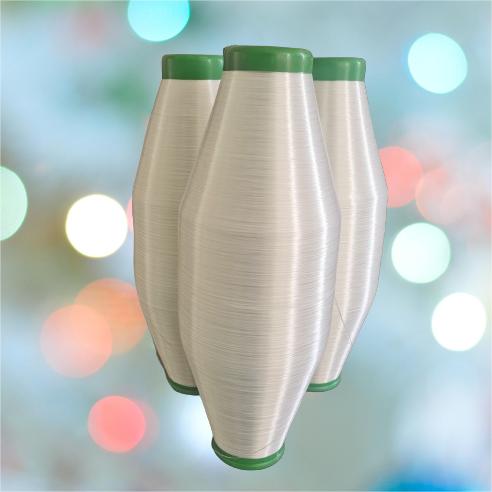Industry-news
Components of Glass Fiber Wetting Agent
Components of Glass Fiber Wetting Agent
Wetting agent is a system composed of a mixture of various organic and inorganic substances. From an external perspective, it can be a solution, emulsion, thixotropic colloid, or paste. Wetting agents are generally composed of film-forming agents, coupling agents, lubricants, additives, and auxiliary components.

(1) Film-forming agent
Film forming agent is the bonding component in the wetting agent, which is the main component for achieving single filament bundling and maintaining the integrity of the original filament. It determines the stiffness and flexibility of the original filament to meet the process requirements of different varieties of glass fiber products. This component has the highest dosage in the wetting agent formula, accounting for 2% -15%, and has a significant impact on the performance and function of the wetting agent. It is the most critical component in the wetting agent. Different formulas require different types of raw materials, and sometimes two or more film-forming agents are used to achieve the desired effect of the wetting agent formula.
(2) Coupling agent
The use of coupling agents is one of the characteristics of enhanced wetting agents. Through its various reactive groups, glass fibers are combined with high molecular weight polymers such as resins, serving as a bridge to achieve good interfacial bonding between inorganic and organic materials, resulting in satisfactory application effects of glass fiber reinforced materials. Different coupling agents have varying effects on the strength of glass fiber composite materials, and it is necessary to select the appropriate type of coupling agent based on the resin matrix material and its curing agent. Usually, the dosage of coupling agent in the wetting agent formula is 0.2% -1.2%.
(3) Lubricant
Lubricant refers to a substance that lubricates the surface of glass fibers and reduces wear in both wet (during wire drawing process) and dry (during wire drawing and textile processing) states. Its dosage in the composition of wetting agents is generally 0-5%. There are significant differences in the type and amount of lubricant used for different purposes of wetting agents.
(4) Antistatic agent
Antistatic agents can effectively reduce the static electricity of glass fibers during processing and use, and their effectiveness is particularly significant in the use of short cut glass fiber wetting agents. The main principle of anti-static action is to reduce the coefficient of friction and form a conductive channel.
(5) Auxiliary components
1. Wetting agent. Wetting agent is a substance with surface activity. It can reduce the surface tension of the wetting agent system, making it easier for the wetting agent to wet the surface of glass fibers and achieve uniform coating of glass fibers.
2. PH regulator. The wetting agent system is generally neutral or weakly acidic, and pH regulators are mostly used to adjust the stability of the wetting agent system and ensure the optimal use effect of the coupling agent. Common pH regulators include formic acid, acetic acid, citric acid, oxalic acid, ammonia, organic amine, etc. Considering that the sizing agent is in direct contact with people and machinery, the pH value in the general formula is in the range of 4-7. For some sizing agents, their film forming agent lotion can be used stably under alkaline conditions, or can meet the required viscosity. The pH value of the sizing agent system is controlled at 8-11, but it is rare.
3. Plasticizer. A substance added to the wetting agent system to improve the flexibility of the film-forming agent. When preparing wetting agents, they can sometimes be directly added to film-forming agents. Commonly used plasticizers include dibutyl phthalate, dioctyl phthalate, tributyl phosphate, etc. The use of single filament plasticizers can sometimes affect the permeability of yarns, and is only used when the performance provided by the wetting agent system does not meet the requirements.
4. Crosslinking agent. After adding crosslinking agent to the impregnating agent system, during the drying process of the raw silk, it will undergo crosslinking reaction with a certain film-forming agent in the impregnating agent, transforming from the original linear molecular structure to a three-dimensional network structure, improving the hardness of the film, which is very beneficial for improving the performance of the hard yarn. However, at the same time, it will bring problems such as difficulty in yarn infiltration and decreased stability of the impregnating agent.
5. Preservatives and fungicides. When the wetting agent formula contains ingredients such as starch, gelatin, hydrogenated vegetable oil, stearic acid or oleic acid lubricants that are prone to spoilage, mold and deterioration, preservatives or fungicides should be used.
6. Defoamer. The film forming agent lotion and lubricant in the sizing agent contain certain surface active ingredients, which are easy to produce foam in the process of mixing and use, bringing inconvenience to production and application. Sometimes it is necessary to add defoamer to eliminate foam. Defoamers are generally organic silicon compounds, which are usually sprayed on the surface after the wetting agent is prepared.

Ganzhou Wolfe Trading Co. , Ltd. is a large Chinese manufacturer and exporter of fiberglass and its products, our main products are fiberglass yarn, fiberglass mesh cloth, fiberglass industrial cloth, fiberglass self-adhesive tape, fiberglass fire blanket, fiberglass-covered aluminum foil self-adhesive cloth, etc. , welcome Chinese and foreign customers to negotiate procurement.
Address: Shangyou County Industrial Park, Ganzhou, Jiangxi province
Tel: 13979783338(Mr. Fang) Web:www.gzwef.com E-mail:fangyulai@163.com
CATEGORIES
LATEST NEWS
CONTACT US
Name: Mr.Fang
Mobile:8613979783338
Tel:8613979783338
Whatsapp:8613979783338
Email:fangyulai@163.com
Add:North Industrial Park, Shangyou County, Ganzhou, Jiangxi,China

